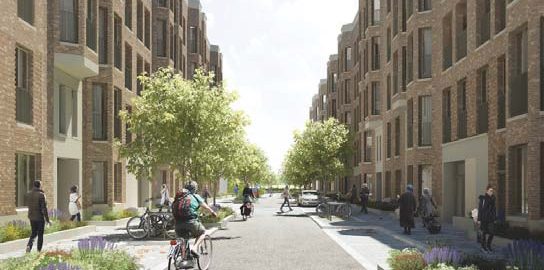Key to the green agenda, particularly in cities, is to get people out of their cars and onto public transport bicycles and even our feet. The rise of the car free scheme is not without its critics. By calculating public transport accessibility levels (or PTAL) it is possible to make a judgement as to whether cars are necessary. The rating from 6, where public transport opportunities are abundant down to 1 where public transport is limited.
Whilst the calculations are not perfect, for example the destinations of each transport option are not considered, PTAL scores are a useful tool for planners and developers to:
- Agree the density of a housing development.
- Decide how to allocate land for car-parking.
Unsurprisingly, in London PTAL scores are high and so are land values so the result is the rise of the car free development with only 10% car parking reserved for blue badge holders.
The first of the car free developments in London have been rolled out and as people move into them, it is clear that the British love affair will the motor vehicle is still strong and the fall in car ownership may take a generation or more to achieve. Where tenants are returning to new-build council housing on regeneration estates they left 8 years ago, the lack of parking is a huge culture shock and in many cases a barrier to them accepting the new home many of them campaigned for. Very few issues have engendered such emotive response as the reduction in car-parking and controlled parking zones.
For new tenants off the homeless register and shared ownership leaseholders it is less of an issue, but I was recently asked by a bus driver living on a car free scheme how he was expected to get to the bus station 6 miles away from his home to drive the first bus of the day. And it is not just the resident who is affected, elderly residents report that visits from their family are tainted with parking anxiety
The problem with using a pseudo scientific calculation of PTAL ratings is that there is no discretion and there are occupations (community midwife, nurses, doctors, bus driver, train driver, etc.) which require the worker to have access to their own transport. I suspect that politicians would probably say get on your bike, from their chauffeur driven cars which are presumably parked overnight in Central London. Many people are too afraid to cycle in urban areas and carrying a week’s shopping with two children in tow is definitely not an option.
There are no incentives to freely surrender your car, car clubs are prohibitively expensive and do not provide the comfort of having a vehicle available to use in an emergency or to know you can travel out of London to see family on a whim. Even with a year’s free membership the take up on a scheme built 3 years ago was zero.
I admit to being a dinosaur, I love my car and the freedom it gives me. I would not move to a car free scheme so I can empathise with residents who are unwillingly leading the way to a London less dominated by cars.
Key things which can assist:
- Full consultation with residents on regeneration estates about parking identifying car use and preparing for a car free future.
- Cost-effective car clubs or car sharing arrangements.
- Discretion to issue permits for people in key occupations.
- Proper arrangements for visitor parking and delivery drop-offs



